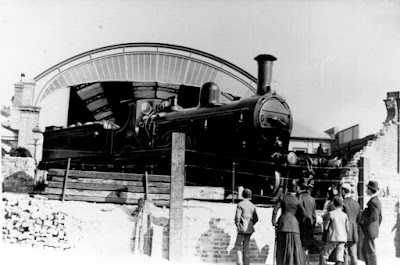From the Daily Mail, Thursday March 11, 2010
QUESTION:
As a child I used to holiday in Ramsgate and would travel by the small open train through a tunnel to the seafront. Is it still there?
KENT Coast Railway opened its branch from Herne Bay through Margate to Ramsgate Harbour in 1863, in competition with South Eastern Railway's line through Canterbury to Ramsgate Town. The latter was on top of the cliffs, about a mile from the seafront, and had opened in 1846.
The Harbour line was originally worked, and soon taken over, by London Chatham & Dover Railway. The LC&DR's advantage, however, was limited by the cramped location of Harbour station as well as the 1,124 yard tunnel on a down gradient of 1-in-75 into the station.
The twin arrangement remained after the LC&DR and SER amalgamated to become the South Eastern and Chatham Railway Management Committee, and when the Railways Act of 1921 came into force in 1923, the Southern Railway was formed. Southern rationalised the situation in Ramsgate and joined the ex-LC&DR line, north of the tunnel, to the SER tracks at Ramsgate Town, forming the present circuit of lines in East Kent. The tunnel and Harbour Station were abandoned.
The former station building was acquired by Thanet Amusements, who opened a funfair and zoo with refreshments. The company was later taken over by Ramsgate Olympia, which decided that the old tunnel should be opened to form a transport link between their facilities and the main line.
After an abortive proposal to re-lay standard gauge track, the decision was made to introduce a 2ft gauge electric tramway. Since it would not be possible to terminate at the north end of the tunnel, a short, smaller dimension tunnel - 8ft high and 6ft wide - was dug from about 344 yards short of the North portal and into a new station at Hereson Road, Dumpton Park. This tunnel was inclined at 1-in-15.
Two trains were bought from the English Electric Company in Pres¬ton. One, the ‘yellow set', comprised two four-wheel electric locomo¬tives, articulated onto a bogie coach, with one each end of two intermediate plain coaches, which had driving compartments so the set could be divided into two, two¬ coach units. The locomotives collected power through trolley poles from overhead wires. The second 'red' set was originally formed similarly. but without the Intermediate driving coaches, as a four-car train. It was later con¬verted to match the yellow train. Ramsgate Tunnel Railway opened on Friday, July 31, 1936. The larger, standard-gauge tunnel was equipped with illuminated tableaux scenes from around the world, to entertain passengers on their four ¬and-a-half minute journey.
Initially, there were two platform lines at each end, enabling a frequent service to be operated, while the main line was single track. In World War II, the line was closed down, and the tunnel was used as an air raid shelter. The line finally closed at the end of the 1965 season. Earlier that year, the only major accident on the railway had occurred, when a loaded train ran away down the line and crashed into the booking office at the harbour. The driver was injured as his cab was crushed between the locomotive and coach.
The owners. Pleasurama, decided not to open the following year, and the locomotives were scrapped. However, several of the coaches still exist at the Holycombe Collection, in Hampshire, hauled by steam locomotives. The sealed-up tunnel mouth by the harbour is all that remains of the railway.
Tim Sanderson,
http://www.elmgate-models.co.uk/,
Haywards Heath, West Sussex.































